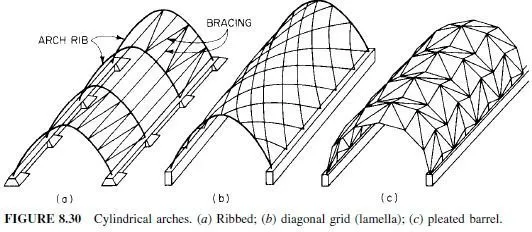These are preferable to arches where the large column-free area to be covered is circular, elliptical, or approximately an equal-sided polygon. They often have been used for the roofs
of exhibition buildings, arenas, planetariums, water reservoirs, and gas tanks. Also, the feasibility of covering large stadiums with domes has been demonstrated. Domes are relatively lightweight, despite long spans, because they can be shaped so that loads induce mainly axial stresses.
Domes may be readily supported on columns, without ties or buttresses, because they can be shaped to produce little or no thrust. For a shallow dome, a tension ring usually is provided around the base to resist thrusts. If desired, however, domes may be extended to grade, thus eliminating the need for walls (Fig. 8.3l). If an opening is left at the crown, for example, for a lantern (Fig. 8.3lb), a compression ring is installed around the opening to resist the thrusts. Also, if desired, portions of a dome may be made movable, to expose the building interior.
Designers have a choice of a wide variety of structural systems for domes. In general, dome construction may be categorized as single-layer framing (Fig. 8.31a and 8.31b);
double-layer (truss) framing, or space frame, for greater resistance to buckling; and stressed skin, with the roof deck acting integrally with structural framing. Greater stiffness can be obtained by dimpling, pleating (Fig. 8.31c), or undulating the surface.
Figure 8.31a shows a ribbed dome. Its principal components are half arches. They are shown connected at the crown, but usually, to avoid a cramped joint with numerous members converging there, the ribs are terminated at a small-diameter compression ring circumscribing the crown. The opening may be used for light and ventilation. If the connections at the top and bottom of the ribs permit rotation in the plane of each rib, the system is statically determinate for all loads.
Figure 8.31b shows a Schwedler dome, which offers more even distribution of the dead load and reduces the unbraced length of the ribs. Principal members are the arch ribs and a series of horizontal rings with diameter increasing with distance from the crown. The ribs transmit loads to the base mainly by axial compression, and the rings resist hoop stresses.
With simplifying assumptions, this system can also be considered statically determinate. For spherical domes of this type. an economical rise-span ratio is 0.13, achieved by making the radius of the dome equal to the diameter of its base.




